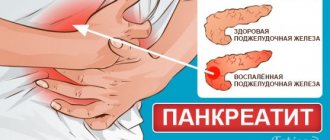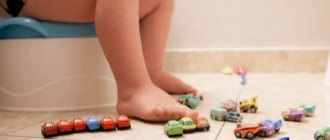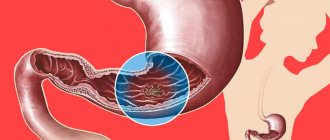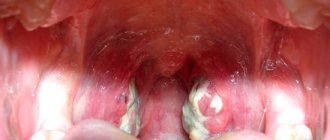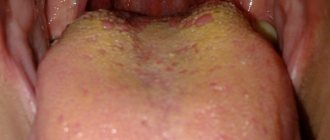When your child is constipated, you need to find out the cause so you know what to do. WHO classifies constipation as a disease, and the World Organization of Gastroenterologists, including Russian ones, classify it as a symptom. It is important to understand that constipation is considered when a child wants, but cannot, go to the toilet. The process is slow and painful. When, after a bowel movement, the baby is left with a feeling of heaviness, as if he “didn’t finish what he started.” Don't confuse constipation with infrequent trips to the toilet. The human body is individual, which affects metabolism. For some children it is normal to walk 3-4 times a week, others walk several times a day. If a child is constipated, we will learn from the article what parents should do at home.
Constipation in children aged 8 years
A child of 8 years old is considered old enough to be able to describe his own feelings and complaints about his health.
Many children at this age are shy and prefer to remain silent about their problems, even if bowel movements cause pain. At 8 years old, a child takes care of his personal hygiene, spends a lot of time at school, and parents cannot control the number of trips to the toilet. In order not to miss the development of chronic constipation, it is recommended to talk frankly with children, convince them to share all their problems, even if they seem trivial or cause embarrassment.
What are the causes of bowel dysfunction in a child?
Constipation is a common problem. The reasons for a child are not always clear. Most often, errors in diet are responsible for persistent obstruction in infants and young children. If a child drinks too much milk and does not eat enough solid foods, the lack of fiber can cause constipation.
Tearing of the skin in the anal area (called anal fissures) can be caused by passing hard stool. This may cause the child to take longer to defecate because it causes pain.
Some children ignore the need to go to the toilet if they are engrossed in play. Constipation occurs more often in children who are overweight and do not exercise enough. Lack of exercise causes the intestines to work less well, which ultimately leads to problems like these.
For various reasons, kids refuse to use the toilet. It happens that toilets in kindergartens and schools do not provide enough privacy and children are simply embarrassed to perform the act of defecation.
Types of constipation in children
Functional.
Such constipation in children 8 years of age is associated with impaired motility of the large intestine. The disease develops gradually and is characterized by stool retention for 5–7 days, followed by the passage of feces in the form of a large-diameter cylinder or numerous small and hard fragments. Functional constipation progresses against the background of rickets, gastroduodenitis, gastritis, and dysbacteriosis.
Nutritional.
They arise due to a violation of the dietary regime, the lack of plant fiber in the diet. Typical for children who switch to fast food, devoid of nutrients and coarse fiber.
Organic.
Such constipation in children aged 8 years appears due to anatomical defects and malformations of the digestive tract. They often develop against the background of rectal atresia, neoplasms, scars in the anorectal area and as a result of adhesive disease.
Infectious.
Such constipation is associated with the toxic effects of microbes and viruses. They most often occur against the background of intestinal infections, long-term inflammatory processes in the digestive tract. Constipation associated with a short-term infection does not require long-term treatment. A one-time use of a laxative is enough to ease the child’s well-being and cleanse the large intestine of feces accumulated during the illness.
What is constipation and why does it occur?
Constipation is defined as slow, difficult, or insufficient bowel movements. When the intestines remain filled with feces and after defecation there is no feeling of complete emptying. Defecation occurs rarely, and the amount of feces is small. With constipation, stool becomes hard and dry. It often injures the intestinal walls. In this case, blood discharge may be observed in the stool.
In healthy people, bowel movements can occur from 3 times a day to 3 times a week. In infants who are fed breast milk, hard and dry feces are considered a sign of constipation. In bottle-fed babies, constipation is the absence of bowel movements for 24 hours. A change in your usual bowel movements can also be a sign of constipation.
A characteristic feature of constipation is the need to strain during bowel movements. Straining, the baby groans and his face turns red. Sometimes a child's constipation can be so severe that straining is not effective. In such cases, the baby cannot empty himself.
There are many reasons for the development of constipation. But most often the cause of constipation is poor diet. A baby may experience constipation due to the mother's poor diet or early introduction of complementary foods. In children on mixed and artificial feeding, constipation occurs due to lack of water or unsuitable infant formula.
What are the dangers of constant constipation?
Chronic constipation leads to intestinal colic, bloating, and an unpleasant feeling of pressure and tension in the anal area. Due to overstretching of the intestinal walls by accumulated feces, microtraumas of the mucous membrane often occur. Constipation may cause fecal incontinence. The child suffers from intoxication, complains of general weakness and fatigue, muscle pain, headaches, and nausea. Occasional constipation can lead to anorexia, skin conditions and anemia, especially if hard stools cause minor bleeding. The child needs qualified assistance from a specialist and the use of a laxative approved for use in this age group. After cleansing the intestines, comprehensive work should be carried out to eliminate factors that contribute to the progression of constipation.
What to do
If a child at three years old begins to suffer from irregular bowel movements, it is important to carry out comprehensive treatment. To do this, you can use special medications, do enemas (glycerin), review your diet and adjust your regimen.
You can eliminate stagnation of feces using a glycerin enema, which is prepared as follows:
- Dissolve 2 teaspoons of glycerin in chilled boiled water. For children aged three, four and five years, the amount of liquid should not exceed 300 ml.
- The syringe is thoroughly disinfected and the tip is lubricated with cream or glycerin.
- The tip is inserted into the anus and water is slowly released into the rectum.
- It is important to remember that at the first urge you need to have a bowel movement.
It is forbidden to do an enema if the stool is dense and contains blood, a characteristic gurgling is heard in the stomach, and severe pain appears, and there are signs of intoxication of the body.
Principles of treating constipation in eight-year-old children
Treatment of acute constipation is mainly symptomatic: a one-time use of a laxative can solve the problem. If fecal retention occurs periodically, it is necessary to approach the problem in a comprehensive manner. Laxatives relieve fecal intoxication and promote gentle bowel movements. But you will have to fight the causes of constipation by changing your diet, eating habits and eliminating the effects of negative environmental factors. It is recommended to give up fast food, constant snacking on dry cookies, buns, and sweets. Vegetable and fruit salads, cereals, buckwheat, oatmeal, millet porridge, slimy soups and jelly are useful for children's digestion.
Enema compositions for home treatment
Enemas are an emergency measure for long-term absence of bowel movements. Regular use threatens intestinal dysfunction and dysbacteriosis. Start with mild laxatives for oral administration and only then resort to enemas.
For infants, the enema is administered while lying on their back with their legs elevated. Place an older child on his side with his knees bent. Heat the injected solution to body temperature. Decoctions of medicinal herbs, Vaseline or vegetable oil, diluted with water in equal proportions, are used. The procedure is painful and can frighten the baby, so you need to act delicately.
MICROLAX ® for the treatment of constipation in children 8 years old
MICROLAX ® can be used in complex therapy for acute and chronic constipation in children 8 years of age. The product promotes the onset of action within 5–15 minutes after use 1. The drug is available in the form of rectal microenemas and does not produce systemic side effects, which allows its use even in early childhood. It is enough to insert the tip of the microenema carefully and without sudden movements and squeeze out the contents. This form of laxative is hygienic and makes it possible to eliminate the unpleasant symptoms of constipation even while traveling.
1 In accordance with the instructions for medical use of the drug MICROLAX ®.
Recovery period
So how to treat constipation in a 3 year old child? If this problem does not recur often, and the child’s behavior does not cause concern, then you can cope with it yourself. First you need to think about what your child eats. From its menu it is worth excluding everything that takes a long time to digest and causes fermentation in the intestines.
For constipation, healthy foods are those that have a large amount of fiber:
- baked pumpkin;
- bran;
- boiled carrots with beets;
- prunes;
- freshly squeezed fruit and vegetable juices;
- curdled milk, kefir and yogurt.
How do traditional healers suggest to deal with constipation in 3-year-old children? They advise giving babies natural oils: olive, pumpkin, flaxseed and others. They need to be added in small quantities to the child’s food. This will help improve peristalsis and soften accumulated feces.
You can also give a child at 3 years old an enema for constipation. This way you will eliminate accumulated feces. Enemas are usually given to babies no more than twice a week, otherwise the intestines will get used to it and constipation will become chronic.
Gymnastics is an equally effective remedy. It improves intestinal motility.
How to quickly help a child with constipation
Before starting self-treatment at home, the child should be shown to a pediatrician to determine the true cause of constipation. Abnormal bowel movements may indicate physiological problems in the intestines - blockage or other pathologies.
Delaying a diagnostic test and trying to cope with an existing problem without the supervision of a specialist can lead to aggravation of the situation.
Pharmacy drugs
Pharmacy counters are overflowing with a variety of drugs to normalize and restore the functioning of the gastrointestinal tract. Parents often have difficulties choosing an effective drug, its form and principle of action. Remedies for constipation have a different spectrum of action:
- Probiotics are drugs that contain beneficial bacteria. The substance, entering the intestines, normalizes microflora, helps fight pathogenic microorganisms, and removes toxins from the body. Probiotics are mandatory for constipation associated with medication treatment. Most often they are produced as capsules with powder. Acceptable for use from early infancy. Popular preparations for use at home are Yogurt, Linex, Laktovit, Bifidumbacterin.
- Glycerin suppositories. A drug that enhances intestinal motility. Glycerin, entering the intestinal cavity, helps to liquefy feces and provokes the urge to defecate. The effect of glycerin suppositories is observed within a period of time from 5 to 30 minutes after insertion into the anus. Another advantage of the home remedy is that it is not absorbed into the bloodstream. Suppositories help children get used to artificial defecation; they should be used only for one-time cases of constipation.
- Syrups are a common form of children's laxative with a pleasant taste for home use. Due to its consistency, it is easily and quickly absorbed, leading to the desired effect. Most existing syrups for constipation are suitable for treating infants, nursing and pregnant women. The main syrup is lactulose, which helps soften stool and enhance intestinal motility. Common medications in this spectrum for children to use at home are Duphalac, Portalac, Normaze, Pomogusha. The course of therapy and dosage is determined by the doctor.
- Microclysters are means for rectal administration that irritate the intestinal walls. The actions of drugs of this form are aimed at stimulating peristalsis and excretion of feces. Common home microenemas are Microlax, Norgalax. The first product is approved for use for children from birth. The second is for adolescence.
Pathologies of the digestive tract
This group includes the following ailments:
- Bile flow disorder. The root cause of constipation in a baby is a spasm or kinking of the bile ducts. Lack of bile makes it difficult for the intestines to digest food.
- Gastritis. The gastric mucosa becomes inflamed, and the initial processing of the food bolus by gastric juice is disrupted. Poorly digested pieces of food provoke reflex spasms, irritating the intestinal mucosa.
- An obstacle to the movement of feces. Swallowed elements of toys and tumors block the intestinal lumen, creating an obstacle to the elimination of feces.
- Damage to the anus. Cracks and tears in the anus appear when a child strains due to constipation. Injuries to the anus cause pain, and babies, trying to avoid painful sensations, restrain the urge to defecate. This is observed in older children who can control the urge to go to the toilet.
If children can talk, if they have gastrointestinal ailments, they complain of abdominal pain. Babies sleep poorly, are capricious and refuse to eat.
Features of effective treatment of constipation in children and adolescents
The effectiveness of treating constipation in young children and adolescents lies in timely detection of the problem, contacting a doctor and starting relevant therapy. It is important to recognize in time what caused the delay in defecation - an easily solvable problem or a pathological condition that harms the child.
Plant fiber and clean drinking water are the key to regular bowel movements. Treating the intestines for constipation at home for children should not be combined with eating fatty foods that are difficult to digest. It is not recommended to give your baby sweets, smoked foods and processed foods. During treatment, it is better to stick to a diet based on natural plant foods, take vitamins and healthy ingredients. Frequent walks in the fresh air and outdoor games are beneficial. Daily bowel movements in the morning help stabilize bowel function.
If constipation is a one-time occurrence, you can deal with the problem in the comfort of your own home. If you experience regular defecation delays, you should consult a specialist. After a thorough diagnosis and passing the necessary tests, the doctor will identify the cause of the disorder and recommend topical medications.
Prevention
Everyone knows that prevention is better than cure. Our simple tips will help prevent the development of constipation:
- the diet must be balanced;
- you cannot feed 3-year-old children with store-bought semi-finished products;
- do not prohibit children from drinking water and compotes;
- Encourage your baby to be active.
Eating, moving and drinking are three ways to prevent constipation in babies. And if stool retention occurs, then think about what caused the constipation and eliminate the causes. Be healthy!
Under what conditions should you consult a doctor?
There are circumstances in which treating constipation at home is dangerous for the baby’s health. You should immediately consult a doctor if:
- lack of bowel movements alternating with diarrhea;
- there is an allergic reaction to laxatives;
- the child complains of severe pain in the stomach or intestines;
- there are symptoms of intoxication;
- constipation developed while taking medications;
- the child is at risk of gastrointestinal diseases;
- laxatives have no effect;
- There was a suspicion of intestinal obstruction.
If constipation in a child continues for more than 5 days, it is necessary to urgently seek help, and not treat it at home in the usual conditions. Delay in finding out the cause of the disorder and relevant therapy at this stage is dangerous for the health of children and can lead to the development of unpleasant consequences.
Treating constipation in children at home is often the norm for parents. It is worth considering the possible causes of this condition. Suspicions of pathological processes are a reason to contact a medical institution.
Description of species
With the physiological type of constipation, stool retention is provoked by:
- physical inactivity;
- insufficient fluid intake;
- abuse of foods with low fiber content (baked goods, protein foods);
- irregular meals and fasting.
Here, physiological retention of stool can be prevented by analyzing the baby’s lifestyle and nutrition.
With the atonic type of constipation, the child develops the following symptoms:
- increased gas formation;
- heaviness in the stomach;
- pain during bowel movements;
- feeling of fullness.
With atony, feces accumulate in large quantities in the lower part of the rectum. When trying to go to the toilet, the baby often complains of pain and cries. Physiological and atonic forms of constipation are identical in manifestations. Intestinal atony is diagnosed by a pediatric gastroenterologist after an examination.
With the spastic type of constipation, the baby experiences muscle spasm under the influence of external factors (unfavorable living conditions, stress). After eliminating the provoking cause, the symptoms disappear on their own. What treatment is needed for spastic constipation in a 3-year-old child? Here, when emptying, rough, dense feces are released, similar to sheep's feces. If your child has constipation accompanied by intestinal colic, do not give a cool water enema. After all, this will provoke a more powerful muscle spasm.
Treatment for constipation can be long-term. The recovery process can last up to two years. After all, it will be necessary not only to restore intestinal activity, but also to eliminate the psychological barrier. The child does not always understand that going to the toilet brings relief.
Folk remedies for constipation for children - the best recipes
Constipation is one of the common problems in adults and children. It is expressed by difficult bowel movements and incomplete bowel movements. Normally, a child should go to the toilet once a day; infants can have bowel movements up to 8–12 times, depending on age. Folk remedies for constipation for children will help to carefully remove feces and clear the intestinal lumen. You can also cope with the problem by using pharmaceutical drugs. In both cases, it is necessary to consult a pediatrician.
Pseudoconstipation
Although children already speak well by the age of 3, this does not mean that they can already clearly understand cause-and-effect relationships. Therefore, it can be difficult to explain why some things cannot be done, while others should be done. They become more emotional and susceptible to criticism, and take unpleasant situations in the family to heart. The child becomes familiar with the feeling of shame and grief, so he usually deeply experiences punishments or negative words addressed to him.
From a physiological point of view, he is able to go to the toilet, but does not do this specifically for personal reasons. Watching him, you can see the efforts he makes to restrain himself.
And although this is not constipation, if this is repeated frequently, it is quite possible to develop a functional intestinal disorder with subsequent fecal incontinence.
Causes of constipation
Every baby has at one time or another experienced problems with bowel movements.
The most common cause of difficult bowel movements in children is an unbalanced diet of the child or an incorrect diet of the mother if the baby is breastfed. Constipation as a result of these problems goes away after normalizing the diet, introducing laxative foods and plenty of fluids. But pediatricians also identify other causes of constipation. Among them:
- The period of potty training - if parents behave incorrectly and put pressure on the child, then the baby may endure the urge and not defecate. Sometimes the baby does not like the potty, he is afraid of it, or it is uncomfortable for him to sit on the potty (for example, the rim is cold, etc.).
- Being in stressful situations - if a child experiences psychological stress, this affects his digestion. The baby suffers from constipation. Such situations occur when a person changes their place of residence, when parents divorce, or when one of them goes on a long business trip.
- Lack of sufficient physical activity.
There are other more serious causes of the disease. They are associated with physiological pathologies:
- incorrect intestinal structure;
- dysbacteriosis;
- malformations of the digestive system;
- worms.
Changes in diet for physiological pathologies will not solve the problem. It is necessary to consult a doctor to identify the true cause. After this, the pediatrician will prescribe appropriate treatment.
Psychological factors
What is psychological constipation in a 3-year-old child? The reason for the impossibility of relief here is moral discomfort:
- Stress. For a baby, this may be separation from their mother, and for older children, it may be their first visit to school or kindergarten, difficulty adapting to a group of children.
- An unfamiliar place. Shy kids cannot relieve themselves in kindergarten or school, but at home they do not experience problems with bowel movements.
- Toilet fear. Are you trying to train your baby to use the toilet or have you purchased a fancy potty, but your child refuses to go big? Think about it: maybe new devices cause fear in a child. No need to insist. It’s better to buy a regular potty, and leave toilet training for later - the baby will grow up a little and will want to relieve himself, like mom and dad.
- Wrong actions of parents. When a mother is potty training a baby, she often scolds him if he doesn’t have time and gets his pants dirty. Natural desire is suppressed by fear of causing discontent. Don’t scold, but simply explain to your child that when you want to relieve yourself, you need to run to the potty.
The psychological factor is difficult to identify. But if the child relieves himself only at home, think about why this is happening. Fear, anxiety or discomfort can cause constipation.
Talk to your little one about how it’s normal to walk around in kindergarten or when visiting. Often, eliminating children's fears eliminates the problem that has arisen. If you are unable to do this, teach your baby to have a bowel movement before going to kindergarten or school.
As you can see, there are many provoking factors here. If you cannot identify the cause, go to your pediatrician.
When you need help
- Exclusively breastfed babies need help to empty their bowels on the second day of no bowel movements, but only if the child is capricious and refuses to breastfeed. If the baby is active, then the absence of stool for up to 5 days is normal.
- For children under one year of age who are bottle-fed, help with bowel movements if the baby does not go to the toilet for two days.
- Preschoolers and schoolchildren go to the toilet once a day, otherwise they need to adjust their diet or take laxatives as prescribed by the doctor.
Diagnostics
With long-term constipation, children sleep poorly and often refuse to eat. In many cases, constipation in children is functional, but in order not to miss a dangerous pathology, parents should consult a pediatrician. In this case, the doctor is obliged to prescribe an extensive diagnosis.
Constipation is a sign indicating some disturbances in the gastrointestinal tract. The longer the constipation, the more undesirable consequences it will have. In the early stages of difficulties during bowel movements, restoring bowel activity is much easier to cope with. But remember that only identifying the underlying cause of the anomaly allows you to choose the right methods and ways to eliminate it.
Don’t rush to treat constipation; first watch your baby. Remember that the transformation of stool frequency is a natural process caused by external factors and nutrition.
Traditional methods of treatment
The methods offered by traditional medicine will help with constipation in children caused by an unbalanced diet. If the true reason is hidden elsewhere, then these methods can be hazardous to health. Before using traditional methods, you should consult your doctor.
- Beetroot juice or boiled beets. This vegetable has a strong laxative effect; the juice is given 2 teaspoons 2 times a day. Grated boiled beets - 1 time per day.
- Prunes are a laxative dried fruit. It can be given to older children (if a child is constipated at 3 years old, 4 years old). These children are already good chewers. Children are given 3-4 pieces of washed prunes. It stimulates intestinal function, softens stool, and helps after 5–6 hours. Children who still have trouble chewing are given store-bought prune puree; it is already ground, without streaks or pieces. But this complementary food is introduced only according to age; first, you should check whether the baby is allergic to the product.
- Freshly squeezed juices – juices from peach, cabbage, carrots and beets are effective. It is advisable to cook them yourself. But you should not overdo it with the drink due to high acidity; it is not recommended to drink freshly squeezed juices if you have stomach diseases.
- Dried apricots are also classified as laxatives. Dried fruits are thoroughly washed, boiled for 30-40 minutes or poured boiling water into a thermos overnight and left overnight. The liquid is filtered and given to drink 20-30 ml 3 times a day.
- Dill water helps even infants. It is effective for colic, abdominal pain, and increased gas formation. The finished mixture is sold in pharmacies - it is diluted with boiled water, according to the instructions. You can make your own water - pour two teaspoons of dry seeds into a glass of boiling water, infuse, then filter. The solution is given to the babies before feeding.
- An apple helps in the fight against childhood constipation. Its pulp is rich in pectin, which weakens the intestines. An adult baby gnaws the fruit on his own; younger children need to puree or buy ready-made apple baby food.
- “Milk” from oats - to prepare it, take 150 grams of oats, pour a glass of boiling water and leave overnight. The mixture must be infused in a thermos. In the morning you need to give the baby the resulting “milk”. But it is only indicated for children over 2 years of age.
- A mixture of honey and aloe. Agave leaves need to be cut and kept in the refrigerator for two weeks. Then they are peeled and thorned and squeezed. The juice is mixed with honey in a 1:1 ratio. The mixture is taken every morning, on an empty stomach. The drug is allergic, it is given if a child 6 years old or older has constipation. At a younger age, give with caution.
- Herbal tea from medicinal herbs. Two tablespoons of dry dandelion root (pre-chopped) are poured into 400 ml of boiling water. After straining, the baby is given water three times a day, 3 hours before feeding.
- An enema is an emergency way to solve the problem. It is made from chamomile decoction or pure water. An enema washes out not only feces, but also beneficial bacteria from the intestines, so it is used only in exceptional cases.
The most effective remedies are decoctions of dried fruits and beet juice.
Nutritional factors
Here the reasons depend on age:
- Poor nutrition for a nursing mother. When breastfeeding a baby, you need to forget about smoked meats, baked goods or fatty meats. These products affect the quality of milk, so infant constipation may occur.
- Replacement of baby food. The formula for feeding varies in composition and is selected individually for infants. Its independent replacement leads to disruption of bowel movements.
- Incorrect introduction of complementary foods. A child’s body needs to be accustomed to a new product gradually, so do not force your baby to eat vegetable puree all at once. Start with a teaspoon and gradually increase the portion.
- Lack of water. Breast milk contains all the necessary components, and it is not necessary to give the baby anything to drink until he is three months old. Artificial babies need fluid even after giving complementary foods. If the drinking regime is disturbed, it will negatively affect intestinal activity. The natural need for water does not need to be limited, because children themselves feel the needs of their body.
- Food allergy. Food intolerance leads to inflammation of the inner surface of the intestine. As a result, it becomes difficult to move feces. Allergies are often triggered by cow's milk, fish, cereals and eggs. Allergies appear after the introduction of complementary foods.
- Recent intestinal infections. If the baby has suffered from salmonellosis, dysentery or other illnesses accompanied by diarrhea, then the malabsorption of the intestinal mucosa during the recovery period causes constipation in the baby.
- Dietary disorder. Don’t buy junk food for your kids at kiosks, don’t give them a lot of sweets and starchy foods. The desire to treat your child with something tasty will lead to stool retention.
Normalization of nutrition is the main treatment for constipation
To get rid of the disease, it is enough to normalize the baby’s diet. After a few days, the child’s health will improve and stool will improve.
- Introducing fiber-rich foods. These primarily include vegetables: beets, carrots, zucchini, pumpkin, cabbage. You also need to introduce fruits and berries: peaches, apricots, apples, raspberries, strawberries.
- It is advisable to start every morning with a glass of warm boiled water.
- Cereal porridges help normalize nutrition: oatmeal, buckwheat, millet, corn.
- An important nutritional element is fermented milk products. It improves the condition of the gastrointestinal tract and populates the intestines with beneficial bacteria.
- The child should be limited in foods that strengthen the stool: baked goods, baked goods, sugar and sweets, rice, potatoes, carbonated drinks.
Pharmacy medications for constipation
Medications are used after a doctor’s prescription. They differ in the principle of action; the wrong choice of medicine can cause harm to the child.
The main groups of laxatives include the following:
- Irritating - they are allowed to be taken by children under 10 years of age and older. The age group from 1 to 3 years is given these drugs in a small dosage, in a gentle version. The active components of irritating drugs penetrate the intestinal lumen, irritate the receptors, increasing peristalsis. After 6–10 hours, emptying occurs. These medications should not be taken constantly or frequently as they cause lazy bowel syndrome.
- A group of osmotic drugs are these products based on salt components. They enter the lumen and draw out the moisture of the adipose tissue. The volume of stool increases, as a result, the child empties easily. The drugs are approved for children over 10 years of age.
- Laxative medications - they are usually used if the child is 2 years old - 10 years old and older (use from 1 to 2 years is also acceptable). They restore intestinal function. The drugs enter the gastrointestinal tract, beneficial bacteria suppress microorganisms and have a gentle effect on receptors in the intestines.
List of pharmaceutical drugs
Laxative medications for children are produced in the same forms as for adults: suppositories, microenemas, drops, syrups, chewable tablets. The only difference is in the dosage of the active component. Some products are fast-acting, others work after 5-6 hours.
Among the most common drugs are the following:
- Duphalac is a good herbal remedy in syrup form. Increases the volume of feces, even for infants from the first days of life.
- Microlax is an effective microenema that can be used immediately after birth. After rectal administration, the microenema acts within 15-20 minutes;
- Glycerol – glycerin rectal suppositories. They act gently, dilute the masses of fecal accumulations, are not addictive, and help for quick emptying;
- Probiotic "Baktisuptil" - acts on the small intestine, suppresses aggressive microflora in the gastrointestinal tract;
- Lactulose is a mild laxative for constipation in children in syrup form. Valid the next day after administration.
Difficulties with bowel movements occur in children of all ages. Many mothers panic and ask what to do if a baby or older child has constipation. The best remedy for constipation is normalizing your diet, introducing fresh vegetables and fruits, and maintaining a drinking regime.
Nutrition correction
In many cases, in order to completely get rid of constipation in a 3-year-old child, it is enough to improve nutrition.
Cooking tips
- The baby should be fed at approximately the same time every day.
- Avoid dry snacks.
- Do not wash down food with cold liquid, as this may shorten the time the food stays in the stomach, which can lead to aggravation of the patient’s condition.
- Maintain a drinking regime - give the child more liquids and liquid foods, as dehydration contributes to constipation.
Products that promote regular bowel movements
| Products | Description |
| Dried fruits | Helps increase the volume of intestinal contents. You can make puree from dried apples, pears, plums (the raw materials are poured with a small amount of clean water, left overnight, and in the morning they are pureed and given to the child along with the resulting infusion). At the same time, children of the first years of life are not recommended to eat prunes and dried apricots. |
| Vegetables | Vegetables and fruits should make up approximately 50% of the daily diet. They can be consumed fresh (vegetables cut into pieces or salads made from them), and also subjected to heat treatment (soups, purees, stewed, baked, fried vegetables). It is recommended to include dishes with various types of cabbage (Brussels sprouts and cauliflower are especially useful), carrots, beets, pumpkin, zucchini, cucumbers, tomatoes, sweet peppers, and leafy greens. |
| Fermented milk products (yogurt, kefir, fermented baked milk, cottage cheese, sour cream) | With regular use, they help improve intestinal functions. It is extremely important that the products are fresh and of high quality. |
| Juices | Freshly squeezed juices from vegetables, fruits and berries can help improve bowel function. Apricot, carrot, pumpkin, apple, and plum are especially useful. It is recommended to dilute juices with water in a ratio of 1:1-1:3. |
| Wheat bran | Wheat bran stimulates peristalsis, can absorb allergens and toxins, and also contains B vitamins. Children 3 years of age are usually recommended to consume 5-10 g of bran per day (be sure to consult your pediatrician first). |
| Beverages | It is recommended to drink clean water. It is advisable to give children bottled and/or water purified using household filters, as well as boiled water cooled to room temperature. |
Diet correction is often enough to solve problems with bowel retention
Products to limit
| Reason for restriction | Products |
| Reduce intestinal contractions | Boiled potatoes and carrots, bananas, pears, quinces, blueberries, jelly, jelly and mousses, semolina and rice porridge. |
| May negatively affect gastrointestinal function in children, including causing constipation | Fresh black and white bread, baked goods, hard cheese, fatty meat (duck, lamb, pork), canned food, smoked products, eggs, fresh onions, mushrooms, garlic, meat (bone) broths and soups based on them, mayonnaise. |
| Foods that cause gas | Sweets, whole milk, legumes. |

